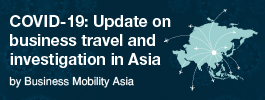G9 Ark’s Fern: We are breaking the NGO-Donor model to restore the planet

G9 Ark aims to break the NGO-Donor model by providing a funding mechanism that fosters collaboration rather than competition among non-government organisations to strategically redress climate change.
- According to G9 Ark’s Stephen Fern, the NGO-Donor model is unable to tackle the climate crisis, and G9 Ark is creating a funding mechanism with a greater pool of money to share, rather than a smaller pool of money to compete over
- Effecting change cannot rely upon philanthropy alone, but must harness a means for individuals and organisations to contribute, such as through G9 Ark’s loyalty programme
- The best way to engage any family office around the world is to get them to discover what has meaning for them
G9 Ark aims to reverse global warming by restoring 500 million hectares of ecosystems on five critical global landscapes across all continents. On the 1st of January 2020, the foundation launched a social network that intends to build a global community by enabling its members to communicate, share and interact.
Two of the project’s funding components consist of: a central foundation that takes donations from companies, family offices, banks and industrial groups and a loyalty reward programme that is operated by a non-profit company out of the United Kingdom.
The reward programme mechanism is structured to enable consumers to obtain points on their personal online application through retail transactions. The strategic thinking behind the funding mechanism is to make it omnipresent and get the largest retailers to sign up, which would allow the scheme to be approximately as large as the annual contribution of the Bill and Melinda Gates Foundation in a week.
For every transaction, a fraction of the value will go into a central pool of funding and be deployed in a collaborative way to specific global projects. For example, a retailer may give a customer more points for buying peanut butter without palm oil, which can help retailers change consumer behaviour and show that they care about the planet.
The final piece in the jigsaw is that every point collected by individuals will take them on their app to the project on the ground, where they will be able to see where each cent was spent through satellite and drone footage as well as regular human updates. Every tree planted and hectare restored will be registered on blockchain and attributed to the pay points.
G9 Ark’s chairman Stephen Fern explained the strategy behind the foundation, its alternative funding mechanism and how private bankers can build loyalty through meaningful client propositions.
Chris Georgiou (CG): Can you tell me how G9 Ark is different from the traditional NGO-Donor type model?
Stephen Fern (SF): One of the issues I have seen looking back on my twenty years of working with family foundations and donations is that the current non-government organisation (NGO) model is not working for a logical reason. When grants and donations are put out by foundations and organisations looking to support a particular activity, in essence, the process is that they dangle the carrot of a large chunk of money, and then 30 to 40 NGOs spend up to six months putting together a bid.
Two things are wrong with that. Ninety-nine percent of NGOs waste a vast amount of time and resources applying for a grant that they are never going to get and it makes the NGOs incredibly competitive.
One of the things we did was ask the NGOs if we can create a funding mechanism that funds all activities, so you no longer need to compete, and can work together. If we can take the best of each NGO and blend them together to create outcomes, with a greater pool of money to share rather than a smaller pool of money to compete over, everybody is better off.
This can also eradicate the very binary process and overheads of applying for a grant. People are turned off by NGOs, as they can see the amount of money spent not on the ground because NGOs are busy going around with a begging bowl to corporates.
CG: I understand that you are implementing a customer loyalty programme. How does this social network work in practice? What are the G9 Ark Rewards points and how can they be used?
SF: This lies at the heart of the funding question of which we are trying to break the back of the NGO model. For decades, the whole funding of NGOs has come from government grants as well as donations from companies and family foundations. What I’m looking for is a mechanism to create funding at scale, funding that stems from what people want to give for commercial reasons rather than altruistic motivations. That is the idea behind our rewards loyalty scheme.
About 85% of the schemes around the world are in effect dormant as they do not actually engage the consumer. The light bulb moment for me was the realisation that global brands are all seeking the same thing. They want to show their customers and employees that they care about the planet.
By creating a G9 Ark loyalty programme where instead of the points being money off the groceries for your next shop, every point counts towards the planet being restored. This is a very powerful way for consumers to be engaged by the brand in terms of being able to say to the customer, ‘We deserve your loyalty and every time you spend money with us, we help the G9 Ark system to restore the global ecosystem.’
CG: So, these points can be used as money by G9 Ark?
SF: Absolutely. Every point issued in effect has two key components. First is the monetary value, which is a marketing programme where each point represents a monetary contribution of one cent to every dollar based on the products consumed. The second component is transparency and a clear message of tying those points into specific items. Every single point represents one kilogram of carbon offsets, which is registered on a global certified carbon credit programme.
What that means is that if you go into a shop and spend $50, you get 50 points and two things happen. Fifty cents goes into restoration of the planet and you get 50 kilograms off your annual carbon footprint. This allows the consumer to be engaged in understanding what their carbon footprint means. We do not want only companies to pledge net zero. We want people to also change their behaviour.
CG: Will you have a team of asset allocators and managers deciding which projects will be funded?
SF: We are in discussions with global banking groups. We are talking about what could be tens of billions a year coming into the programme. The idea being that it is deployed quickly. We don’t have years to wait. We already have programmes in Australia and Africa that we want to scale up on a previously unimaginable level.
CG: An example of this is the nationwide landscape restoration programme in Australia. Congratulations on the launch last month. Could you tell us a bit more on the specific activities being developed? I understand G9 Ark has committed to fund the first phase of the programme implementation.
SF: In terms of global programmes, we are looking at doing things strategically at scale. Australia provides the perfect opportunity to establish how that framework works.
Australia is at the forefront of the climate crisis for advanced economies. The wheat belt and the Great Barrier Reef are two huge ecosystems under threat. The raging bush fires this year offer a great illustration of how disjointed the thinking is. At that time, hundreds of charities raised their flags willing to do their bit here and there, whereas we already had an approach based on the strategic restoration of Australia’s ecosystems through my previous work at Restore Australia.
We are not going to plant a million trees here and there. It’s about developing a framework that creates landscapes resilient to droughts and fires as well as a regenerative agriculture. It is also about throwing away the model of vast scale monocrop farming and taking us back to nature that has huge circular benefits.
Post the coronavirus disease (COVID-19) pandemic, the world needs an economic stimulus and what better way for governments to recognise what COVID has taught us about connecting with nature.
CG: In terms of the $158.6 million (AUD 250 million) committed to this Australian programme, can you share what is the composition of the philanthropic donors? Are they predominantly individuals, corporates or government agencies?
SF: We are not a donor-driven model. Although originally my network G9 consisted of billionaire families around the world, the funding is basically coming from multiple sources within the G9 Ark programme, including foundations and global corporates that are both donating as well as making net zero commitments of buying carbon credits, individual donations and through the reward scheme over the five-year period.
CG: In line with your G9 Family Office programme, are you still working with family offices to educate the next generation on value investing through G9 Ark?
SF: I spent twenty years with many of the world’s wealthiest families with one clear mission: to get the families to align their wealth with their values. G9 Ark really would not exist without that twenty-year background, because in many ways the reason most of our families have become billionaire families is because they own a global brand.
The lightbulb moment was when it became clear I couldn’t go to families with the begging bowl out to get this scale of money in. They absolutely want to engage their children and grandchildren with specific components of the projects because this is not just about giving money, it is giving purpose and meaning. Every one of those brands has an overriding marketing objective to show their customers they care about the planet.
CG: How can private banks have a more meaningful client proposition for their clients?
SF: It is almost a given in banking that you are going to look after a family’s financial affairs to the best of your ability, but what differentiates private bankers is the real relationship and knowing the family. This is effectively your own loyalty programme. The best way to engage any family around the world is to get them to discover what has meaning for them.
When you have money, it’s very easy to understand that money does not provide fulfilment. It can provide contentment through accumulation, but fulfilment is the application of one’s special skills to something one feels passionate about. That’s why children and grandchildren can lose their way by following the road to contentment.
As a private banker, you can say to your client that we can be part of one of the most important legacies for your grandchildren to protect the planet. Having ownership of your own special part of this collective mission, visiting the projects and being part of a team can all be built into a programme around families and their foundations. That is connecting the G9 Family Office world with the G9 Ark world, which is for everybody.












Leave your Comments